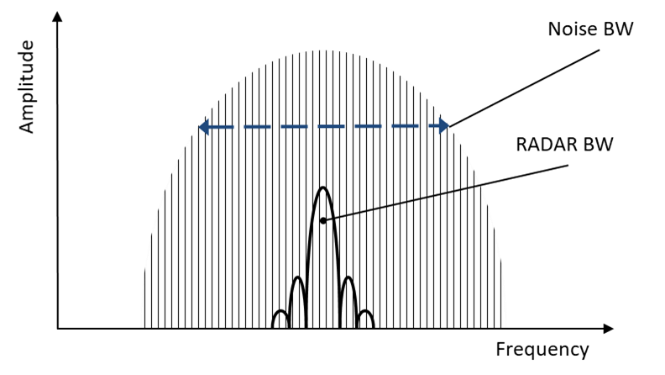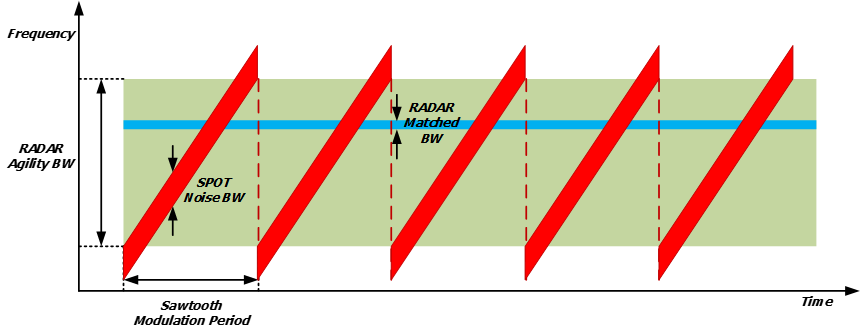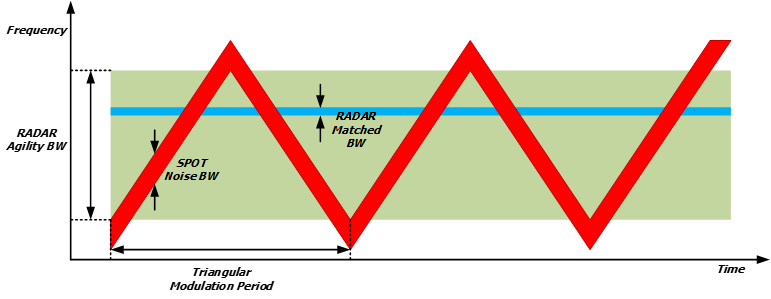Spot Noise
Spot Noise is a self-screening or support ECM technique that transmits narrowband noise-like energy for masking signals received by a victim electronic system.
Spot-noise jamming concentrates jamming noise-like energy over a narrow frequency band such that a high jamming density can be produced in the bandwidth of a victim electronic receiving System.
Spot Noise waveforms are obtained through the transmission of a carrier modulated by noise:
- Jamming carrier can be generated in one of the following ways:
▪ Non-coherent:
– through digital synthesis of a carrier at the frequency of the countered radar track.
– through synthesis of multi band/multi lines spectrum.
Radar frequency value is given to the jammer by the RWR, upon reception and measurement or directly indicated by the EW Manager without reception (RWR and EWM are other equipment in the self-protection suite).
▪ Coherent:
– through detection and memorization of the threat radar signal (in this case the jammer is provided with an autonomous narrow band receiving and processing capability, the frequency value measured by the RWR is used to tune the jammer receiver).
– Spot Noise modulation is usually a random phase modulation of the jamming carrier obtained through specific devices (analog VCO or digital modulation depending on the systems) that allow applying independent noise modulations on every jamming signal without the need of dedicated resources.
Different values are obtained through the combination of phase pseudo-random noise modulation and frequency modulation.
Spot Noise can be adapted to radar instantaneous frequency bandwidth or to Doppler bandwidth (e.g. to mask semi-active seeker speed gate) and requires look-through or alternate RX-TX operation to follow threat frequency (coherent jamming).

Figure 1: Continuous Spot Noise
- Jamming Noise performance can be defined in terms of global S/N reduction when jamming is added to noise (signal to noise plus jamming ratio) if noise characteristics can be assumed similar to thermal (Gaussian) noise.
A Noise Quality Index (NQI) can be defined, which corresponds to closeness to Gaussian characteristics.
Noise quality index is also dependent by the ratio between the jamming BW and the radar matched BW, a good noise quality is obtained with a minimum jamming BW to Radar BW ratio of a factor 3.
Noise Jamming Techniques can be combined with modulation of different types for several purposes.
▪ slow increase/decrease : to take control of radar AGC or to gradually hand over AGC control to other signals or to chaff/decoy
▪ Inverse Gain.
As an alternative to Barrage Noise it is possible to wobble a spot jamming frequency in a wide band (this is useful to maintain a good NQI). Therefore, this is called swept jamming:
▪ Swept audio modulation (also known as Scan Rate Modulation)
▪ Swept Scan Band, Noise Swept Audio, LORO deception, SORO deception, Swept Square Wave
▪ Frequency Modulation is usually part of noise generation.

Figure 2: Sawtooth modulation applied to SPOT noise jamming to counter an agile Radar
Amplitude modulation can be of several types: slow increase/decrease : to take control of radar AGC or to gradually hand over AGC control to other signals or to chaff/decoy
- Inverse Gain.
As an alternative to Barrage Noise it is possible to wobble a spot jamming frequency in a wideband (this is useful to maintain a good NQI). Therefore, this is called swept jamming:
▪ Swept audio modulation (also known as Scan Rate Modulation)
▪ Swept Scan Band, Noise Swept Audio, LORO deception, SORO deception, Swept Square Wave
▪ Swept Scan Band, Noise Swept Audio, LORO deception, SORO deception, Swept Square Wave

Figure 3: Triangular modulation applied to SPOT noise jamming to counter an agile Radar







